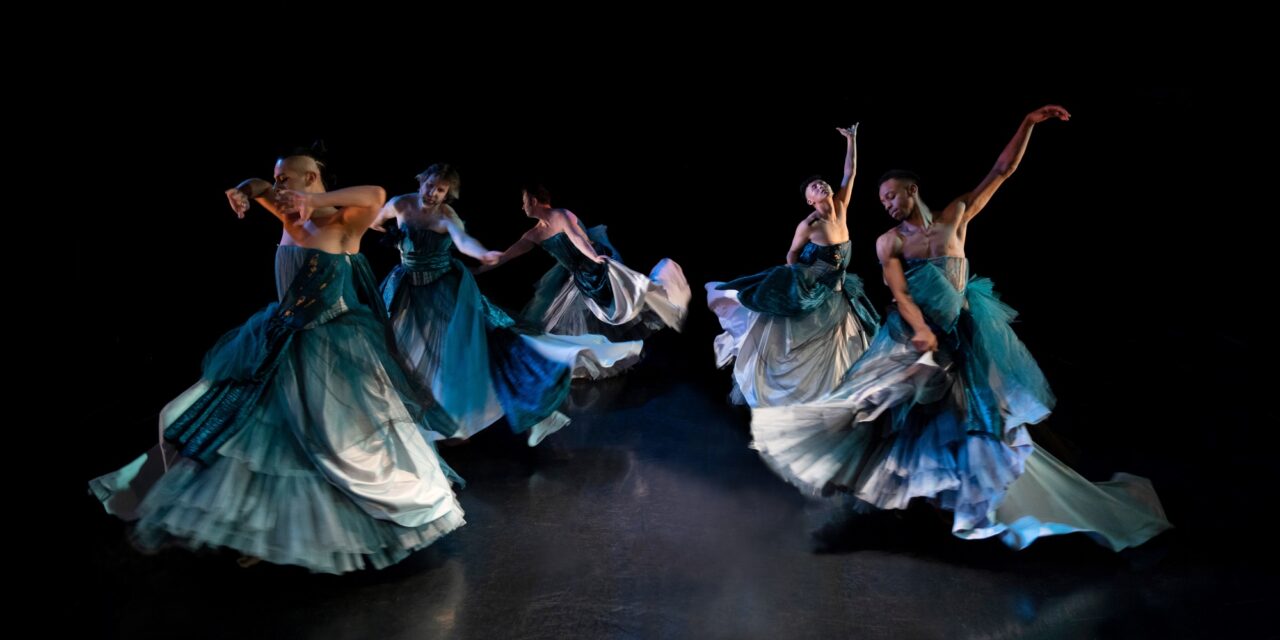What makes us feel so small? As the company of Sean Dorsey Dance spread their arms out wide, reaching up to the sky, they prove that there is no reason to feel that way.
The Lost Art of Dreaming, which was presented at Highways to commemorate the 35th anniversary of the venue, explores the importance of self-worth with each expansion of the body. Dorsey challenges the audience to dream bigger by transporting the audience into the sky with otherworldly movement and imagery.
Dorsey is known for centering his movement in a narrative often outlined by dialogue. This show was no different. As the ensemble flowed with each other, he questioned why we feel so small when we have no reason to be. The dialogue introduced a series of movement motifs based on the extremities, accenting the remainder of the show with its themes of expansion and self-love.
The movement was most impactful when the ensemble — made up of Dorsey, Brandon Graham, Héctor Jaime, David Le, and Nol Simonse — moved together. It is in these moments where you see their individuality shine, even when they are performing the same choreography. Their movement flowed from the ground to the sky as a single dancer was lifted by the rest of the ensemble, bathing their face in light. It was like witnessing a star shoot across the stage.
Ironically, the messaging faltered when the ensemble diverged from each other. As Jaime, Le, and Simonse moved from one side of the stage to the other with varying movement, they felt disconnected. It caused impactful dissonance at first but lost its edge when there was no sign of unity ahead.
The first half of the show included a broad variety of themes, resulting in no unifying throughline. Although the sections were vast, there were still highlights. In a solo by Jaime, they proclaimed “Pleasure is a revolution.” The dialogue and sensual movement were a unique addition to the show. Their subtlety in the physical range allowed the energy from the previous sections to settle, offering space for a nice deep breath to reflect on pleasure.
The second, more cohesive half of the show centered on the origins of the earth. It began by explaining that everything — including us — started from a star. We are made of stardust, the show announced. During a monologue, dancers pinched at the space in front of them as if they were touching star after star, arching back behind them to count them passing by. At one point, the lighting design by Clyde Sheets even cast a sea of stars over the performers. The progression of the narrative surrounding the stars was beautiful. Dorsey stepped on stage for a solo, showing love for his “trancestors.” His choreography at this moment was subtle and soft, depicting a sense of love and care for humanity and the trans community.
The ensemble section in this half of the show was remarkable. The music was more rhythmic, presenting an opportunity to explore musicality. A reverberating bounce within the movement kept the ensemble moving, lifting, and swinging — all elements that had not been explored as much until this point in the show. The dancers were finally able to stretch their limbs and physically thrust themselves into the story. They relinquished control to gravity, making for a suspenseful performance. Through it all, there was a contagious vibration.
The narrative naturally shifted from life to death. Graham, Jaime, and Dorsey stood on stage as Simonse entered in an intricate dress made by the costume design team of Tiffany Amundson, Krystal Harfert, and Melissa Castaneda. Simonse’s dress contained a long train that continued off-stage, continually growing as he traversed the space. He had a loving moment with each performer, touching foreheads and making a beautiful connection before moving forward. The train intertwined their bodies as he moved between them and back to the other side of the stage. The imagery represented the lasting impression of life, depicting Simonse entering their lives and leaving behind a loving community. In one last grand embrace, they connected again before lifting Simonse up to the sky. The imagery of death was not dark, but warm, making the life event feel more like a celebration of love than a daunting end.
The show concluded with another bit of strong imagery. The ensemble sat on the ground in elaborate dresses that covered the stage in multicolored fabric and shimmering textures. They moved in unison, arching back before folding into themselves to revisit movement motifs like the rolling of arms and twisting of hands. It was like watching the waves of water flow and crash. Before the lights went out, they reached forward, touching the stars one last time.
The Lost Art of Dreaming was a reminder of the power of community. The show informs us of our birthright to things like joy, pleasure, freedom, and liberation, even at a time when queer and trans communities are under attack across the country. We are all shining stars worthy of being admired and loved.
To learn more about Sean Dorsey Dance, please visit their website.
To see the season lineup at Highways Performance Space, please visit their website.
Written by Steven Vargas for LA Dance Chronicle.
Featured image: Sean Dorsey Dance in The Lost Art of Dreaming – Photo by Lydia Daniller.












